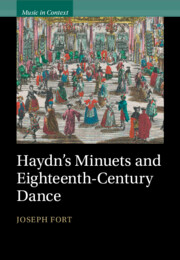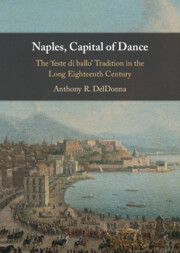Refine search
Actions for selected content:
13 results
Epilogue
-
- Book:
- Haydn's Minuets and Eighteenth-Century Dance
- Published online:
- 12 September 2025
- Print publication:
- 02 October 2025, pp 210-213
-
- Chapter
- Export citation
4 - A Somatic Enquiry into the Minuet
-
- Book:
- Haydn's Minuets and Eighteenth-Century Dance
- Published online:
- 12 September 2025
- Print publication:
- 02 October 2025, pp 137-176
-
- Chapter
- Export citation
5 - Somatic Analysis of the Concert Minuets
-
- Book:
- Haydn's Minuets and Eighteenth-Century Dance
- Published online:
- 12 September 2025
- Print publication:
- 02 October 2025, pp 177-209
-
- Chapter
- Export citation
2 - The Choreography of the Viennese Minuet as a Group Dance
-
- Book:
- Haydn's Minuets and Eighteenth-Century Dance
- Published online:
- 12 September 2025
- Print publication:
- 02 October 2025, pp 62-97
-
- Chapter
- Export citation
1 - The Dance Culture of Late Eighteenth-Century Vienna
-
- Book:
- Haydn's Minuets and Eighteenth-Century Dance
- Published online:
- 12 September 2025
- Print publication:
- 02 October 2025, pp 11-61
-
- Chapter
- Export citation
Introduction
-
- Book:
- Haydn's Minuets and Eighteenth-Century Dance
- Published online:
- 12 September 2025
- Print publication:
- 02 October 2025, pp 1-10
-
- Chapter
- Export citation
3 - The Music of the Viennese Minuet
-
- Book:
- Haydn's Minuets and Eighteenth-Century Dance
- Published online:
- 12 September 2025
- Print publication:
- 02 October 2025, pp 98-136
-
- Chapter
- Export citation

Haydn's Minuets and Eighteenth-Century Dance
-
- Published online:
- 12 September 2025
- Print publication:
- 02 October 2025
4 - The Dance Treatise in the Age of Reason
-
- Book:
- Naples, Capital of Dance
- Published online:
- 10 April 2025
- Print publication:
- 17 April 2025, pp 75-94
-
- Chapter
- Export citation

Naples, Capital of Dance
- The ‘feste di ballo' Tradition in the Long Eighteenth Century
-
- Published online:
- 10 April 2025
- Print publication:
- 17 April 2025
3 - The Minuet
-
- Book:
- The Viennese Ballroom in the Age of Beethoven
- Published online:
- 25 November 2021
- Print publication:
- 02 December 2021, pp 55-74
-
- Chapter
- Export citation
Chapter 3 - Thinking on Our Feet: A Somatic Enquiry into a Haydn Minuet
- from Part I - Conceptual Studies
-
-
- Book:
- Musicology and Dance
- Published online:
- 09 September 2020
- Print publication:
- 27 August 2020, pp 71-90
-
- Chapter
- Export citation
5 - Final Focus
-
- Book:
- Instrumental Music in an Age of Sociability
- Published online:
- 19 September 2019
- Print publication:
- 10 October 2019, pp 515-558
-
- Chapter
- Export citation
